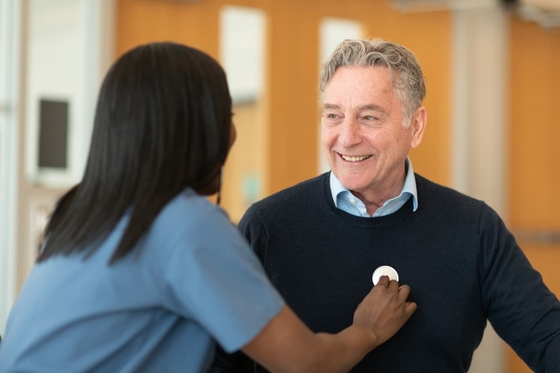
Driving and travelling after a heart attack
Key takeaways
2 min read
- If you’ve had a heart attack, check with your doctor when you can safely start driving again. They can advise on how long you should wait.
- You can usually travel straightaway as a passenger in a car, train, tram or bus.
- If you need to travel by plane, check with your doctor when you can safely fly.
Driving after a heart attack: what you need to know
A heart attack might stop you from driving for a little while, but most people return to it once they’ve recovered. Make sure you’ve got clearance from your doctor so you can get back behind the wheel safely and with confidence.
Read on for answers to common questions about driving after a heart attack.
How soon can I drive after a heart attack and/or procedure?
How long you should wait depends on if you had any procedures, surgery or complications. General suggested wait times are listed in the table below. These are just a guide though. Be sure to check in with your doctor before you start driving any kind of vehicle again. This is important both for your safety and the safety of other road users.
|
Condition / Treatment |
Suggested waiting time before driving again |
|---|---|
|
Cardiac arrest |
At least six months |
|
Coronary artery bypass graft (CABG) surgery |
At least four weeks |
|
Heart attack |
At least two weeks |
|
Angiogram |
At least two days |
|
Angioplasty/stent |
At least two days |
|
Implantable cardioverter defibrillator (ICD) insertion |
At least six months after cardiac arrest |
|
Cardiac pacemaker insertion |
At least two weeks |
If you drive a commercial vehicle (for example, a truck or forklift), be aware that there are longer waiting times before returning to driving.
Keep in mind some medicines can also impact your ability to drive. Ask your doctor or pharmacist about whether your medicines have any side effects. This is very important, especially if you drive a commercial vehicle.
Will my driver’s licence be affected?
If you have had a heart attack, you can still drive. But by law, you must report any health condition that could affect your driving. This includes a heart attack. You need to report a heart attack after it happens, and not just when you next renew your licence. To check what you need to do, contact the licensing agency in your state or territory.
The licensing agency may have some conditions or restrictions to make sure that you can drive safely. For example, your licence might require that:
- you stick to minimum non-driving periods
- you’re responding well to your treatment
- you have minimal symptoms that could affect driving (for example, chest pain or feeling short of breath)
- you see your doctor for regular review
- there is minimal pain in your muscles and bones after surgery.
Your doctor might make recommendations about having a conditional licence. This means you can still drive, but with some restrictions. The licensing agency will make the final decision. It’s your responsibility to comply with any conditions on your licence.
Contact your state or territory office for more information.
- Australian Capital Territory
- New South Wales
- Northern Territory
- Queensland
- South Australia
- Tasmania
- Victoria
- Western Australia
Will my car insurance be affected?
If you start driving before the end of the suggested waiting time, and you have an accident, your insurance might not cover you. You might need to inform your healthcare insurer about your heart condition to be covered. Speak with them to find out what you need to tell them.
Travelling after a heart attack
You can usually travel straight after your heart attack as a passenger in a car, train, tram or bus.
Check with your doctor when you can travel by plane. You may need a medical clearance form to do so. If you’re unsure, ask the airline about any travel requirements.
Your travel insurance cover may be affected by a new heart condition. You may require a medical assessment, and the cover may be more expensive. Talk with your doctor before buying travel insurance.
Here are some tips for travelling after a heart attack:
- Long trips may make you feel tired, or you may get car sick more easily than usual. Try to have regular breaks.
- When on public transport, sitting instead of standing can make you feel less tired.
- If you find public transport stressful, try to arrange alternatives for the first few weeks, and avoid peak hour traffic.
- If you’ve had heart bypass surgery, try placing a cushion, pillow or rolled-up towel between your chest and the seat belt to help to reduce pressure on the wound while it heals.
- Speak with your insurer – whether it’s for driving or travelling – to ensure that you’re covered if anything happens.
More information
For information about travelling safely with your heart medicines, visit our Heart medicines – Frequently asked questions webpage.
References
- National Transport Commission. Assessing fitness to drive for commercial and private vehicle drivers. 2022. https://austroads.gov.au/__data/assets/pdf_file/0037/498691/AP-G56-22_Assessing_Fitness_Drive.pdf
You might also be interested in...

Heart attack recovery – your next steps
Explore the Heart Foundation’s guide on the next steps you can take to recover after a heart attack and get back to doing the things you love.

Returning to work after a heart attack
Discover how to plan for your return to work.

Support after a heart attack
Many different thoughts may go through your head after a heart attack and you may be presented with complicated medical info. Know where to get support.
Last updated14 October 2025
Last reviewed19 March 2024
